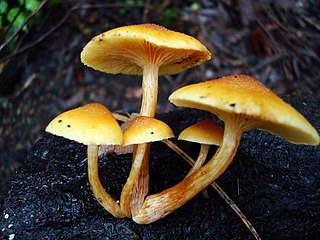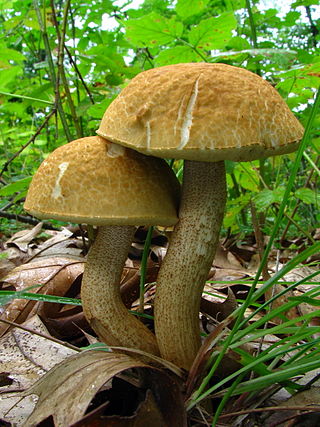
Rubroboletus pulcherrimus, known as Boletus pulcherrimus until 2015, and commonly known as the red-pored bolete, is a species of mushroom in the family Boletaceae. It is a large bolete from Western North America with distinguishing features that include a netted surface on the stem, a red to brown cap and stem color, and red pores that stain blue upon injury. Until 2005 this was the only bolete that has been implicated in the death of someone consuming it; a couple developed gastrointestinal symptoms in 1994 after eating this fungus with the husband succumbing. Autopsy revealed infarction of the midgut.

Amanita brunnescens, also known as the brown American star-footed amanita or cleft-footed amanita is a native North American mushroom of the large genus Amanita. It differs from A. phalloides by its fragile volva and tendency to bruise brown.

Gymnopilus aeruginosus, also known as the magic blue gym, is a mushroom-forming fungus that grows in clusters on dead wood and wood chip mulch. It is widely distributed and common in the Pacific Northwest. It has a rusty orange spore print and a bitter taste and contains the psychedelic chemical psilocybin. It was given its current name by mycologist Rolf Singer in 1951.

Leucoagaricus leucothites, commonly known as the smooth parasol, woman on motorcycle, ma'am on motorcycle, white dapperling, or white agaricus mushroom, is a species of agaric fungus. The species was originally described as Agaricus leucothites by Carlo Vittadini in 1835, and bears similarity to species of that genus. Solomon Wasser transferred it to Leucoagaricus in 1977. While sometimes regarded as edible, the species is suspected of being poisonous due to gastric-upset-causing toxins. It could also be confused with the deadly Amanita ocreata.

Gymnopilus luteoviridis is a widely distributed mushroom-forming fungus of the Eastern United States that contains the hallucinogens psilocybin and psilocin.

Agaricus pattersoniae is an edible species of mushroom. It is found in the United States, where it associates with cypress trees. It has been proposed for inclusion in the IUCN Red List of Threatened Species.

Agaricus lilaceps, also known as the cypress agaricus or the giant cypress agaricus is a species of mushroom. It is among the largest and most choice edible Agaricus species in California. Aside from size, Agaricus lilaceps is characterized by a robust stature, as the stipe often club-shaped.

Leucopaxillus albissimus, commonly known as the large white leucopaxillus, is a species of mushroom that lives as a saprobe, decaying the litter under coniferous trees. It produces a large white fruiting body that is unusually resistant to decay. It is considered to be inedible.

Agaricus arorae is a moderate-sized, forest-dwelling mushroom that exhibits distinctive color changes. It fruits early in the mushroom season. Unusually within the genus Agaricus, the mushroom's cap cuticle turns yellow when exposed to a base such as potassium hydroxide or sodium hydroxide but stains red when cut. In the field, it has a brownish, fibrillose/squamulose cap, which turns red when bruised. Agaricus arorae was first described from Santa Cruz County but since has been found in San Mateo and Alameda counties. Agaricus arorae can be distinguished by its scales and a conspicuous stipe.

Agaricus albolutescens, commonly known as the amber-staining agaricus, is a moderate-sized, stocky-statured mushroom with a pleasant odor; it bruises slowly but persistently yellow.

Agaricus perobscurus, commonly known collectively with its close European relative Agaricus lanipes as the princess, is a basidiomycete fungus. A relative of Agaricus augustus, known as the prince, A. perobscurus can be differentiated in several aspects. While the prince is widely distributed in North America, the princess is found only in the San Francisco Bay Area. Besides its smaller size, it is distinguished from Agaricus augustus by a darker-brown cap, a patchy fibrillose stipe surface at youth, lacking densely floccose-scaly, and a different fruiting season. Another commonly closely associated Agaricus species, Agaricus praeclaresquamosus, is toxic. It can be differentiated by its dark-grey cap, a phenolic, rather than an anise odor, and a stipe base which yellows immediately when injured.

Agaricus benesii is an agaric mushroom of the genus Agaricus known in English as the mull mushroom. This mushroom can be distinguished by a white cap that bruises pinkish-red when injured, a scaly lower stipe, and a conifer habitat. Similar to Agaricus californicus and A. xanthodermus, the cap discolors brown in age. A distinguishing feature of A. californicus and A. xanthodermus, however, is a thickened annulus at the margin, a phenolic odor, and a yellowing bruise, instead of red. In the case of Agaricus xanthodermus, it occurs quickly, though faintly to not at all in the case of A. californicus. Another similar species, Agaricus bernardii, also stains red and has white flesh, but differentiates on its larger bulk, a sheathing veil, briny odor, and different habitat, namely grass.

Butyriboletus appendiculatus is an edible pored mushroom that grows under oaks and other broad leaved trees such as beech. It is commonly known as the butter bolete. It often grows in large colonies beneath the oak trees, and is frequently found cohabiting with old oaks in ancient woodland. It is relatively rare in Britain. Its stipe and pores are often bright yellow and its flesh stains bright blue when cut or bruised.

Leccinum manzanitae is an edible species of bolete fungus in the family Boletaceae. Described as new to science in 1971, it is commonly known as the manzanita bolete for its usual mycorrhizal association with manzanita trees. Its fruit bodies (mushrooms) have sticky reddish to brown caps up to 20 cm (8 in), and its stipes are up to 16 cm (6.3 in) long and 3.5 cm (1.4 in) thick. They have a whitish background color punctuated with small black scales known as scabers. Found only in the Pacific Northwest region of the United States and Canada, it is the most common Leccinum species in California. The mushroom is edible, although opinions vary as to its quality. L. manzanitae can be usually distinguished from other similar bolete mushrooms by its large size, reddish cap, dark scabers on a whitish stipe, and association with manzanita and madrone.

Suillus pungens, commonly known as the pungent slippery jack or the pungent suillus, is a species of fungus in the genus Suillus. The fruit bodies of the fungus have slimy convex caps up to 14 cm (5.5 in) wide. The mushroom is characterized by the very distinct color changes that occur in the cap throughout development. Typically, the young cap is whitish, later becoming grayish-olive to reddish-brown or a mottled combination of these colors. The mushroom has a dotted stem (stipe) up to 7 cm (2.8 in) long, and 2 cm (0.8 in) thick. On the underside on the cap is the spore-bearing tissue consisting of minute vertically arranged tubes that appear as a surface of angular, yellowish pores. The presence of milky droplets on the pore surface of young individuals, especially in humid environments, is a characteristic feature of this species. S. pungens can usually be distinguished from other similar Suillus species by differences in distribution, odor and taste. The mushroom is considered edible, but not highly regarded.

Mycena maculata, commonly known as the reddish-spotted Mycena, is a species of fungus in the family Mycenaceae. The fruit bodies, or mushrooms, have conic to bell-shaped to convex caps that are initially dark brown but fade to brownish-gray when young, reaching diameters of up to 4 cm. They are typically wrinkled or somewhat grooved, and have reddish-brown spots in age, or after being cut or bruised. The whitish to pale gray gills also become spotted reddish-brown as they mature. The stem, up to 8 cm (3 in) long and covered with whitish hairs at its base, can also develop reddish stains. The mycelium of M. maculata has bioluminescent properties. The saprobic fungus is found in Europe and North America, where it grows in groups or clusters on the rotting wood of both hardwoods and conifers. The edibility of the fungus is unknown. Although the species is known for, and named after its propensity to stain reddish, occasionally these stains do not appear, making it virtually indistinguishable from M. galericulata.

Agaricus hondensis, commonly known as the felt-ringed agaricus, is a species of fungus in the family Agaricaceae. The species was officially described in 1912 by mycologist William Alphonso Murrill, along with three other Agaricus species that have since been placed in synonymy with A. hondensis. Found in the Pacific Northwest region of North America, A. hondensis fruits in the fall under conifers or in mixed forests.

Leccinellum rugosiceps, commonly known as the wrinkled Leccinum, is a species of bolete fungus. It is found in Asia, North America, Central America, and South America, where it grows in an ectomycorrhizal association with oak. Fruitbodies have convex, yellowish caps up to 15 cm (5.9 in) in diameter. In age, the cap surface becomes wrinkled, often revealing white cracks. The stipe is up to 10 cm (3.9 in) long and 3 cm (1.2 in) wide, with brown scabers on an underlying yellowish surface. It has firm flesh that stains initially pinkish to reddish and then to grayish or blackish when injured. The pore surface on the cap underside is yellowish. Fruitbodies are edible, although opinions vary as to their desirability.

Pluteus americanus is a North American and Russian psychedelic mushroom that grows on hardwoods.

Leucoagaricus badhamii is a species of fungus in the family Agaricaceae and genus Leucoagaricus. The flesh of this mushroom turns blood red when cut or bruised, hence its common name of blushing dapperling. These damaged areas may eventually turn brown or black and likewise the mushroom may discolour brown or black with age. All parts of the flesh display red staining aiding in identification.




















